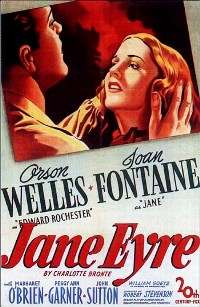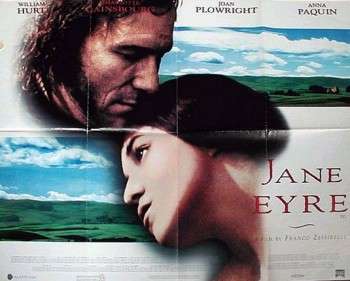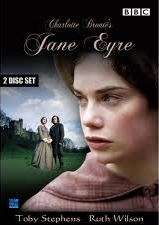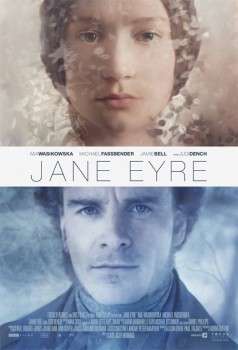Jane Eyre (film)
 | This page needs some cleaning up to be presentable. This page needs to be broken out into separate pages for each film listed below, and then turned into a disambiguation page listing them. |
|---|
From Aldous Huxley's intriguing Orson Welles/Joan Fontaine 1943 film, through Charlotte Gainsbourg and William Hurt's performances in Franco Zeffirelli's 199 film, Ciaran Hinds and Samantha Morton in a 1997 ITV film, Ruth Wilson and Toby Stephens' work in the 2006 BBC miniseries, and the most recent 2011 film directed by Cary Fukunaga and starring Mia Wasikowska and Michael Fassbender, Jane Eyre has never been short of adaptations. A consistent trait of all the adaptations is the conversion of Jane and Rochester from plain or unhandsome to good-looking or downright stunning -- a clear case of Adaptational Attractiveness.
The various versions of Jane Eyre are:
1943 film

The classic film starring Joan Fontaine as Jane and Orson Welles as Rochester. Co-adapted by Aldous Huxley, after his work on Pride and Prejudice
- Adaptation Dye Job: Blanche is blonde.
- Dawson Casting: Joan Fontaine was 26, eight years older than Jane's 18. Elizabeth Taylor appeared the first time as Helen Burns in an uncredited spot.
- Early-Bird Cameo: St. John Rivers appears during Jane's childhood as the local clergyman. This removes him from consideration as a romantic rival to Rochester when he reappears at the end (fortunately, given the age and power difference), and reformulates his obstacle to Jane's choice as a spiritual rather than emotional/marital one.
- Chiaroscuro
- Guttural Growler: Rochester.
- Ice Queen: Blanche has a haughty personality, but she is allowed to make her exit with some dignity.
1996 film

Franco Zeffirelli's adaptation of the novel starring Charlotte Gainsbourg as Jane and William Hurt as Rochester. Notably also includes Anna Paquin as the young Jane.
- Dawson Casting: Charlotte Gainsbourg was 25, seven years older than Jane's 18 - though her build and height work well.
- Early-Bird Cameo: St. John and his family appear when Jane returns to her childhood rearing house to attend her aunt's final illness. While not on the level of either the 1943 or 2011 films in including him from the very beginning, it is still earlier than his final-quarter appearance in the novel.
- Pragmatic Adaptation: Though in general the film plays like an Adaptation Distillation, the final Rivers section is combined and manipulated quite a bit to fit it into a coherent, unified narrative.
1997 telefilm

ITV's telefilm starring Samantha Morton (the 1996 Emma) as Jane and Ciaran Hinds (the 1995 Persuasion) as Rochester.
- Adaptation Dye Job: Blanche is a blonde.
- Big No: When Richard Mason reveals Rochester is already married.
- Dawson Casting: Almost averted, as Samantha Morton was 20 (the youngest Jane Eyre so far), only two years older than Jane's 18.
- Deadpan Snarker:
Rochester: "Perhaps you'll explain to me the concept of a twenty-eight day week..."
2006 miniseries

The BBC's return to the story in four episodes after the last miniseries in the 83s. Starring Ruth Wilson as Jane and Toby Stephens as Rochester, scripted by Sandy Welch (Our Mutual Friend, North and South, the 2009 Emma), and directed by the BBC's Bleak House co-director Susanna White.
- Adaptation Dye Job: Blanche is again blonde. Rochester is a redhead.
- Toby Stephens's hair looks as though it has been dyed and you can only really tell he's a natural redhead from his sideburns and occasionally in the sunlight.
- Book Ends: The series begins and ends with the painting of a family portrait.
- Canon Foreigner: The Dent twins and John Eshton, setting up the idea that twinned souls can call each other across distances and making the ending feel much less like a sudden fantastical Deus Ex Machina.
- Dawson Casting: Ruth Wilson was 25, seven years older than Jane's 18.
- Pragmatic Adaptation: While it is one of the longer versions, the script makes a few choices to fit the serialized format of the series. A particular example of this is the structure of the fourth episode, which plays with the idea that Jane doesn't remember Thornfield.
- "Shut Up" Kiss: Rochester does this a number of times to Jane when begging her not to leave Thornfield to the point that one Youtube user said that it sounds like Toby Stephens is eating Ruth Wilson's face.
2011 film

Focus Features produced this film, starring Mia Wasikowska as Jane, Michael Fassbender as Rochester, Judi Dench as Mrs. Fairfax, and Jamie Bell as St. John, and directed by Cary Fukunaga.
- Almost Kiss: When Rochester is "thanking" her for saving him from the fire.
- Beard of Sorrow
- Cat Scare: Just before Jane encounters Rochester, she is startled by a bird.
- Dawson Casting: Mia Wasikowska was 20, two years older than Jane's 18 - though like Charlotte Gainsbourg in the 1996 film, she fits the part well.
- Dutch Angle: When Helen dies, the camera is tilted as Jane is taken away.
- Early-Bird Cameo: The positioning of the Rivers section as framing narrative means that all three of the Rivers siblings get these.
- Eerie Pale-Skinned Brunette / Messy Hair: Bertha.
- "Falling in Love" Montage: To the film's credit, it's not overdone.
- Identical Stranger: While not identical, there is a strong resemblance between Adèle and the younger Jane, highlighting how Jane identifies with Adèle.
- Like Brother and Sister: Invoked, and subverted.
Diana: "Isn't Jane our sister, too?"
St. John: [Hesitates, then kisses Jane on the lips]
- Longing Look: There are a lot of these.
- Pragmatic Adaptation: The restructuring of the film into using the Rivers sequence as a framing narrative, and the childhood and Rochester sections as semi-flashback material qualify as a clever attempt to reshape the story's unwieldy, commonly frustrating structure into a satisfying two hour film. The film might otherwise qualify for Adaptation Distillation, though many events and causes are finessed to fit a more "naturalistic" rather than Romantic tone.
- Relationship Compression: Jane and Rochester seem to fall for each other rather quickly (to be fair, it's extremely hard to keep the relationship building sections while trying to include the full plot of the novel).
- Say My Name: Well, Say His Name.
- Spiteful Spit: Bertha casually spits at Jane.
- Vertigo Effect: Twice. First during the Red Room scene, just before an ash cloud explodes from the fireplace, and second just before Jane meets Rochester for the first time (after being startled by the bird).
- Woman in White: Bertha.